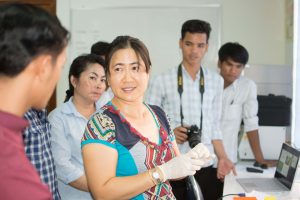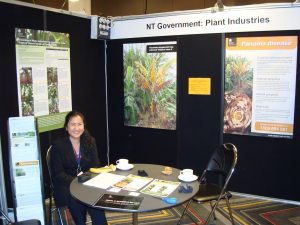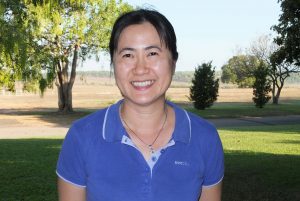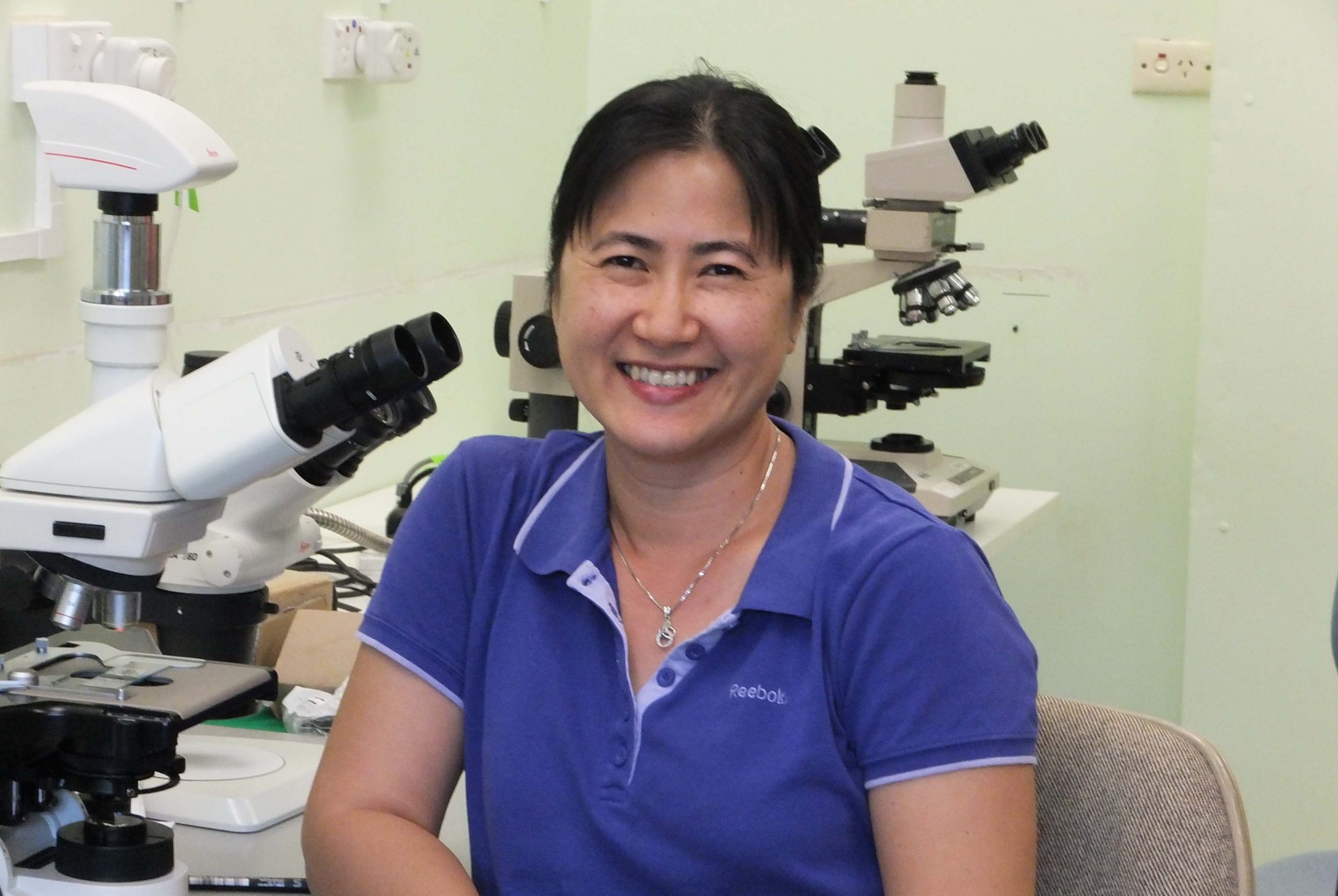Meet Dr Lucy Tran-Nguyen: The Top End ‘ologist’
Dr Lucy Tran-Nguyen has been a horticultural researcher for almost 24 years, with resounding success. In 2016, Lucy was awarded the Bayer-sponsored 2016 Researcher of the Year award for her efforts in managing the 2014/15 Cucumber green mottle mosaic virus (CGMMV) outbreak. In this column, Lucy reflects on the award and her research, plus provides an update on her current activities and thoughts on research in the vegetable industry.
Lucy, you won the Researcher of the Year award at the Awards for Excellence in 2016. What are you up to now? What is your current role?
In January this year, I moved from the Top End to Canberra and joined Plant Health Australia (PHA) as the National Manager: Diagnostics. This follows just over three years in the Principal Plant Biosecurity role at the Northern Territory (NT) Government’s Department of Industry, Tourism and Trade (the department).
In between winning the award and now, I have been involved with the national citrus canker eradication program following the detection of the exotic bacteria in April 2018. While at the department, my portfolio included biosecurity preparedness for our agency, but also our industries and identifying funding opportunities for early detection surveillance and diagnostics.
Can you please provide a short overview of your career as a researcher (to date)?
Since completing my PhD in phytoplasma genomics in 2007, I have focused my research career on diagnostics, continually to learn and broaden my knowledge into plant health – particularly in pathology.
In the NT, we didn’t get the opportunity to specialise in any particular area or industry as the team had so much to cover. So, I would call myself an ‘ologist’ pending on what was needed. I joined the department in 2007 to establish molecular diagnostics in the plant labs. From there, it was a steep learning curve in mycology and a suite of different plant pests that impacted our NT industries (mangoes, vegetables, melons etc).
I was involved in many exotic plant pest incursions while in the NT; most notably, mango malformation, banana freckle, Cucumber green mottle mosaic virus (CGMMV), fusarium wilt of watermelon, mango fruit borer, citrus canker – to name a few. Research areas include varietal testing, management options for Panama wilt, CGMMV, fusarium wilt of watermelon, fusarium wilt of snakebean to citrus canker research. All the time, my passion for molecular diagnostics – and finding different ways to do things – remains.
Not only did I love spending time in research, but I was also interested in building capacity and capability in plant health. In my previous role as the Principal Molecular Scientist, I had the opportunity to work overseas to develop diagnostic protocols and work on exotic plant pests to get ready for when they arrived in Australia.
Being involved in Australian Centre International Agriculture Research allowed me the opportunity to work and train colleagues in Cambodia and get out in the field more (a strange thing for a molecular scientist).
Back in the NT, capacity building meant building my team around early career scientists who had a chance to gain a footing in research, work in remote areas, and learn to adapt quickly under a small team with so many opportunities. I was provided a similar opportunity fresh out of university, so I wanted to give something back.
I have been in involved in several research programs that have been funded by Hort Innovation to support the vegetable, melon and banana industries (VG07125, VM12001, VG15013, VG16086, BA10020, BA14013, BA14014 and BA16001) and Rural Research for Profit project to boost diagnostics.
I find it rewarding when my PhD students complete their candidature and graduate. I gave up the researcher hat to go into the space of policy, preparedness and research grant writing to allow me the space to grow in the strategy head space. I wanted to take my on-the-ground learnings and try to help industries in other ways.
But I still retain my science interest by co-supervising two PhD students who are working on phytoplasmas and CGMMV in the VG16086 project.
As mentioned, you received the Researcher of the Year award at the National Horticulture Convention in 2016. What did winning the award mean to you at the time?
2016 was tough. Leading up to winning this prestigious award, I was working on both banana freckle and then Cucumber green mottle mosaic virus. This also included securing funding for the VG15013 CGMMV management project.
Personally, it was a tough year to manage work/life balance as my late father got his initial diagnosis, so I was also his carer. I was surprised and deeply humbled to be recognised and nominated for this award; as to me, I was doing what I love and gave it my all.
How long have you worked in the vegetable/horticulture field?
I have been working in the horticulture industry since 1998 (wow!) and specifically vegetables since 2007.
What type/s of vegetable industry research have you conducted since 2016?
From 2016-2019, I was the project lead for VG15013 that looked at management options for Cucumber green mottle mosaic virus.
This was on the back the initial detection of CGMMV in the NT and Australia in 2014. In this national project, I led a team of awesome researchers in the NT, Queensland, Victoria, New South Wales and Western Australia to identify the true host range of CGMMV including weed species along with the role of honeybees in epidemiology and studies on CGMMV longevity in soil.
In addition, as CGMMV became widespread in the NT and WA, we needed to ramp up our extension activities (with AUSVEG and NT Farmers Association) and work with our cucurbit growers (melons, vegetables, Asian vegetables) to help them to increase their on-farm biosecurity, improve understanding of the virus and helping them continue their business while living with CGMMV.
After the successful completion of project VG15013, the NT team also secured another project (VM18008) to look at CGMMV and honey bees, which was a strategic levy investment under the Melon Fund.

What research are you conducting at the moment (if any)?
Nowadays I don’t get to actually do any research. As I mentioned, my research involvement is through my two PhD students in the VG16086 and VM18008 projects.
However, while in the NT, I did write many research grants and project proposals to get funding for the plant biosecurity team in diagnostics, early detection and surveillance, industry preparedness and biosecurity training.
We recently finished a project on development of artificial scent lure for citrus canker and have a great collaboration with Charles Darwin University and the local Darwin-based company, Top End Conservation Dogs, which has a couple of dogs trained to detect the citrus canker scent. We are looking to continue the momentum in the volatile technology space.
What did you find most challenging about working in vegetable industry research in the Top End?
I felt it was the diversity of the vegetable industry in the Top End – the crop varieties, the number of pests and the demographics of the small vegetable grower groups.
We spent a large time working and making connections with our vegetable growers, where English is their second language and – due to their backgrounds – have a natural distrust towards government. So, our work with NT Farmers included extension and building relationships. Transferring and extending research outcomes to growers could at times be challenging.
What do you enjoy most about being involved in vegetable research?
I love how resilient the vegetable industry is. It gets exposed to so many different pests and diseases, which expresses a unique suite of symptoms. Aside from the diagnostics, I enjoy and understanding the epidemiology of the disease: how it got there, how it spreads, what options and help does the grower need to prevent spread and reduce the economic impact.
Is there any particular vegetable or horticulture research project that stands out to you as one that was successful/ interesting, or that can be built upon?
I have been involved in so many different vegetable and/or horticulture research projects that it is hard to identify one in particular. But I find projects that support the research to investigate new varieties and test against pest resistance, as well as capacity building to maintain Australia’s level of expertise in the fields and management options, all provide critical outcomes for industry.
Where do you think more vegetable research needs to be undertaken (e.g. pest and disease)?
I am keen to see more applied research such as the use beneficial microbes to reduce pathogen inoculum in the soil, what can be done to break the life cycle of resting spores, stable virus particles etc. How can it be maintained long term? What are the applications such as hyperspectral imagery technology for example – that can be used to screen large vegetable cropping areas to increase surveillance sensitivity?
There is some really cool research being conducted overseas on vertical vegetable growing structures, innovative ways to irrigate, monitor and screen for disease symptomology. I’d like to see some of that here in Australia.
Do you have any future plans in research – is there a particular subject or area you’d like to pursue?
Grower-led surveillance and crop monitoring, diversification of products, artificial intelligence and/or machine learning. Regarding the latter, would it be useful for the vegetable or horticulture or is it just a fad.
I am keen to understand and hear more from the growers what do they want or need from researchers? This should help guide the research and channel the funds accordingly as if industry is interested from the start, there is buy-in at the end to adopt the research findings.

A distinguished career in research
Below is a list of Hort Innovation strategic levy investments that Dr Lucy Tran-Nguyen has been involved in. These encompass the vegetable, melon and banana industries.
VG07125 – Best Practice IPM strategies for control of major soilborne diseases of vegetable crops
This research was directed towards the development of IPM based strategies for the management of key soilborne diseases (caused by the pathogens Sclerotinia, Pythium, Fusarium and Rhizoctonia spp.) in vegetable crops.
VM12001 – Characterisation and management of Fusarium wilt of watermelon
Fusarium wilt is one of the most severe diseases of watermelon and is caused by the soil-borne fungus Fusarium oxysporum f. sp. niveum (Fon).
This project identified the Fon race(s) found in the NT compared with other Australian and international (USA) Fon isolates; screened rootstocks and grafted watermelon seedlings for resistance to Fon; and raised awareness of Fusarium wilt and propose management options to industry through extension strategies.
VG15013 – Improved management options for Cucumber green mottle mosaic virus
This project investigated how the Cucumber green mottle mosaic virus (CGMMV) is spread in cucurbit production as well as alternative hosts for the virus and farm biosecurity protections that growers can implement.
VG16086 – Area wide management of vegetable diseases: viruses and bacteria
Beginning in 2018, this investment is responsible for developing an ‘area wide management’ (AWM) strategy to address high-priority viral and bacterial diseases affecting vegetable crops.
VM18008 – Understanding and managing the role of honey bees in CGMMV epidemiology
Beginning in July 2019, this project is exploring how honey bees are able to introduce Cucumber green mottle mosaic virus (CGMMV) into melon crops, and is developing management practices to combat this for both the melon and apiary industries.
BA10020 – Banana plant protection program
This project was focused on understanding the fungus that causes Fusarium wilt Tropical Race 4 (TR4) and whether it was possible for the fungus to be transmitted through the tissue culture process. In addition, a large component in the NT was to conduct variety field trials to identify resistant varieties. This project was paused due to the outbreak of Banana Freckle in the NT and banana plants including those in the trials had to be eradicated.
BA14013 – Fusarium wilt Tropical Race 4 – biosecurity and sustainable solutions
This project had a focus on biosecurity strategies around the Fusarium wilt Tropical Race 4 (TR4) fungus – one of the most destructive diseases of banana. The work delivered new science, information and practices to help in avoiding, containing, and managing TR4.
BA14014 – Fusarium wilt Tropical Race 4 research program
This investment built a strong foundation for the Australian banana industry to manage Fusarium wilt with minimal impact on production, by addressing three key areas: prevention, resilience and resistance.
BA16001 – Improved plant protection for the banana industry
BA16001 focuses on access to and evaluation of banana varieties with improved pest and disease traits; access to clean planting material that has been pathogen tested; enhancing the diagnostic capacity for endemic and exotic threats; and improving integrated pest and disease management.

Find out more
To get in touch with Dr Lucy Tran-Nguyen, please email LTran-Nguyen@phau.com.au.
Readers who have any questions or would like further details about the below levy funded projects, please email Northern Territory Government’s Department of Industry, Tourism and Trade’s media department at media.ditt@nt.gov.au.
About the award
The Bayer Researcher of the Year award recognises a leading agricultural researcher who has helped to advance the industry through their work, and actively encourages growers to implement research outcomes on-farm. Award nominations are now open, closing on 15 April. Click here for further details.
Credit: Images courtesy of the Northern Territory Government’s Department of Industry, Tourism and Trade.

